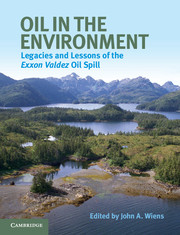Book contents
- Frontmatter
- Contents
- List of contributors
- Use of acronyms
- Acknowledgments
- A bibliographic note
- Prologue
- Part I Introduction and background
- 1 Introduction and background
- 2 The phases of an oil spill and scientific studies of spill effects
- Part II Oil in the environment
- Part III Biological effects
- Part IV Assessing oil spill effects and ecological recovery
- Part V Conclusions
- Index
- References
1 - Introduction and background
Published online by Cambridge University Press: 05 July 2013
- Frontmatter
- Contents
- List of contributors
- Use of acronyms
- Acknowledgments
- A bibliographic note
- Prologue
- Part I Introduction and background
- 1 Introduction and background
- 2 The phases of an oil spill and scientific studies of spill effects
- Part II Oil in the environment
- Part III Biological effects
- Part IV Assessing oil spill effects and ecological recovery
- Part V Conclusions
- Index
- References
Summary
Introduction
In the aftermath of an oil spill, the effects on the environment and wildlife are often painful to see. After the initial emotional impact come the questions: What wildlife and environments are at risk, and when will they recover? How can the oil be removed without causing further harm? Is it safe to eat the seafood or to be on the beaches? What will happen to the oil? Science can offer objectivity, rigor, and focus in addressing such questions, helping to separate fact from fiction, evidence from conjecture. A science-based approach defines potential spill effects and then formulates testable hypotheses, follows an unbiased study design, collects and analyzes data using rigorous methods, and interprets the results with a mind open to alternative explanations that evolve during the investigations. This is how good science is done.
Conducting science following the Exxon Valdez spill was not always easy, however. Along with everyone else, the first scientists on the scene were distraught over what they saw – shorelines awash with oil, oiled seabirds and sea otters (Enhydra lutris) struggling to survive, and fisheries closed for fear of contamination. It was challenging to come up with good, objective study designs. The remote location of the spill and the wide variation among places in the spill zone complicated data collection. Studies conducted at different times or of different durations produced different results, and relationships documented at different spatial scales did not always match. Study designs often seemed to be confounded by other factors or uncontrolled sources of variation at every turn, making it difficult to separate changes in the environment due to the oil spill from changes due to other, unrelated factors.
- Type
- Chapter
- Information
- Oil in the EnvironmentLegacies and Lessons of the Exxon Valdez Oil Spill, pp. 3 - 36Publisher: Cambridge University PressPrint publication year: 2013
References
- 1
- Cited by



